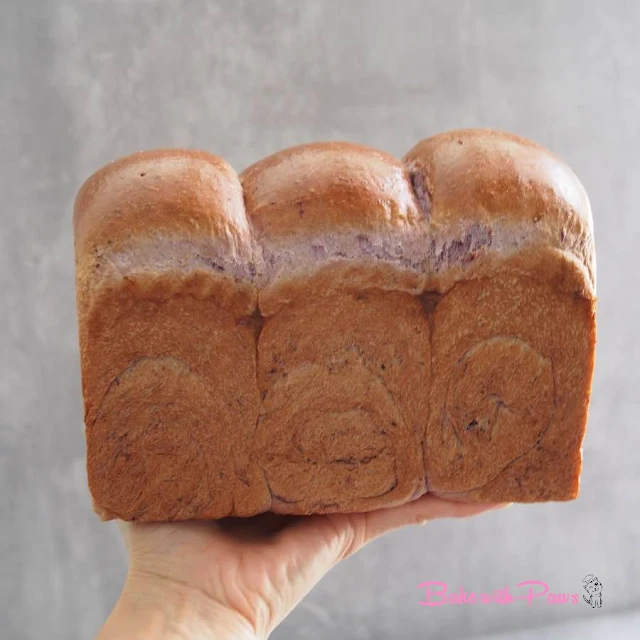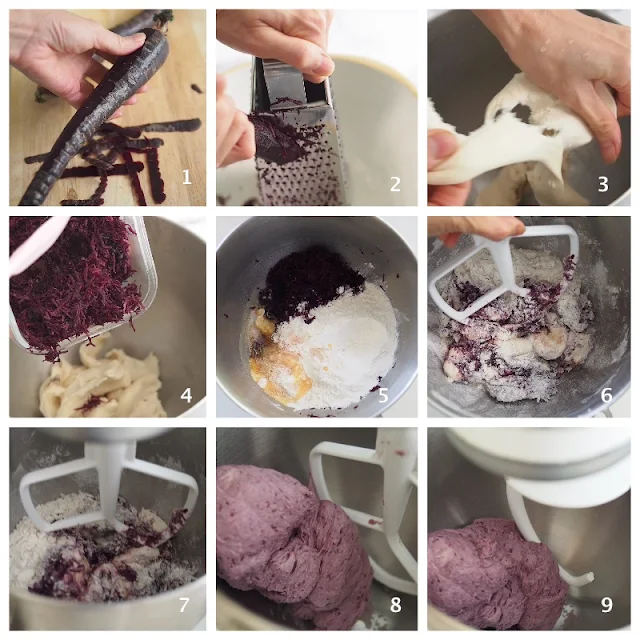Breads (Yeast) - Loaves
Purple Carrot Bread
October 09, 2018
| Recipe by Bake with Paws
Scroll to the bottom of the page for "PRINT RECIPE" ⬇
It is very rare to find purple carrots where we are. When I saw these I jumped on the chance and picked them up without any idea of what I would do with them. We had some of raw with the humus and it was just delicious as it is. I thought it would also be nice in bread.
I am really happy with the result this Purple Carrot Bread. The deep purple is just amazing and attractive to me. This old dough method yields a very soft, moist and chewy bread.
I used pâte fermentée (pre-fermented dough in French) or sometimes called "old dough" to make this soft and flavourful bread. Traditionally, bread makers take a portion of the bread dough made and save it overnight for next day baking. I made it from scratch since I did not have any ready old dough. With this method, the bread is more flavourful and aromatic due to the higher acidity and fermentation gasses produced during the slow fermentation.
Please click on Bread Making Method to understand more details.
If you have any questions regarding this recipe or any other post, please leave me a comment in the “LEAVE A COMMENT” link and I will reply you as soon as possible. Do tag me on Instagram @Bakewithpaws if you attempt on this recipe.
Recipe - Purple Carrot Bread (Old Dough Method)
Yields: 1 Loaf
INGREDIENTS:
Old Dough:
175g bread flour (I used Japan High Gluten Flour)
115g liquid (75g milk + 40g water)
1/4 tsp instant yeast
1/4 tsp sugar
Main Dough:
175g bread flour (I used Japan High Gluten Flour)
All the old dough above
85g grated purple carrot (from 1 medium carrot)
1/2 tsp (2.5g) instant yeast
20g brown sugar
1 tsp (5g) salt
45g egg, whisked
20g milk (Don't add all at one time)
35g butter
Egg Wash (Optional):
1 egg + 1 Tbsp water, whisked
(You may want to use the balance of egg from the above if any)
Utensil:
450g loaf pan (21.3 X 12.2 X 11.5 cm / 8.4" X 4.8" X 4.5")
METHOD:
- Old Dough:
- Combine water and milk mixture, yeast and sugar in a bowl of stand mixer. Then add in bread flour and slightly combine the mixture by hand with the paddle attachment before turning on the machine so that the flour will not splash out. Turn on the machine and mix with paddle attachment until become a soft dough. Roll into a ball and place in a greased bowl. Cover with cling film and let it proof 1 hour in room temperature (28C – 30C).
- After 1 hour, place into the refrigerator overnight for at least 12 hours or up to 16 hours. Fridge temperature 2C - 4C. The next morning, take out the old dough from refrigerator to return to room temperature 30 minutes before using. You can also use directly from the fridge if you forget to take out earlier.
- If you don't plan to bake the next day, after 1 hour fermentation, shape it into a ball and wrap it in cling wrap or place it in a ziplock bag. Store it in the freezer for 1-2 months. Take it out 30 minutes before using to defrost.
- Carrot:
- Wash, peeled and shred the carrot with a grater. Keep aside.
- Main Dough:
- Put all ingredients (except butter) including all the old dough and grated carrot into a bowl of stand mixer. Using the paddle attachment, mix for 2 minutes or until all incorporated. Change to hook attachment and knead for another 2 minutes or until the dough comes together. Add in butter and continue knead for 10 - 12 minutes or until reach window pane stage. During the whole kneading process, I stopped few times to scrape down the dough from the hook to be sure it is evenly kneaded and also to prevent the motor from overheating.
- First Proofing:
- Let the dough proof in a warm place (my room temperature 28C - 29C) for 45 to 60 minutes or until double in size in a large greased bowl, covered with lid or kitchen towel.
- Shaping:
- Punch down the dough to release the air. Transfer the dough to a clean floured surface then divide into 3 equal portions (about 225g per portion) or 2 portions at your choice.
- Form each portion to a ball. Rest for 5 - 10 minutes.
- Flatten with rolling pin into a dish.
- Fold right to centre and fold left to meet in the centre. Roll out with rolling pin into long rectangle shape. Roll up the dough like Swiss Roll until a small log is formed.
- Place all dough in a loaf pan.
- Second Proofing:
- Let the dough rise for about 45 - 60 minutes slightly below the rim of the pan. My room temperature 28C - 29C.
- To bake:
- Brush with egg wash.
- Bake in a preheated oven at at 190C (top & bottom heat) or 170C (fan-forced) for 25 - 30 minutes, or until golden brown.
- I usually preheat oven for 15 minutes before baking.
- Remove bread from oven and let them cool on rack completely before slicing.
GENERAL NOTES:
GLUTEN DEVELOPMENT & WINDOWPANE TEST
Gluten forms when flour comes in contact with water. Hydration of the flour causes the sticky and stretchy protein to form, giving structure to the bread. This makes your bread trap air and rise.
Gluten in dough can be developed by autolyse, resting, kneading or folding.
The windowpane test is used to determine whether the dough has been sufficiently kneaded. By gently pulling the dough (or you may pinch off some dough) and trying to stretch it into a thin membrane. If you are able to stretch the dough paper thin and translucent without tearing, then the gluten is fully developed. However, if you can stretch it without tearing but the membrane is not transparent, then the gluten is not yet fully developed.
However, from my experience not all the recipe can achieve a thin and translucent window pane stage easily. For example low hydration and low fat dough. For such recipes, a reasonable window pane is good enough and it can be left to rest. Gluten will continue to develop while resting. Exercising restraint to not over-knead the dough prevents the gluten from being overworked and broken. Some of you may have experienced the dough breaking during the second proofing. It is because the dough is over kneaded.
The total kneading time for me is usually 15 minutes at low speeds except brioche dough with high fat percentage or dough using liquid fat which usually takes a little longer (maybe 18-20 mins).
From my experience, I found that high hydration dough with high percentage of fat will be easy to stretch and achieve a paper thin windowpane stage.
KNEADING TIME
For kneading, please regard the timing provided as an indication only. It is only meant as a guide. Timing may differ depending on the brand of flour and electric mixer used. The protein content may vary from one brand of flour to another.
FLOUR
The right flour plays a very important role in bread making. To achieve fluffy, soft and light bread, I used Japan High Gluten Flour in most of my bread baking. The protein content is around 12 - 13%.
HYDRATION
The liquid measurement given is also a guide. It is advisable to always reserve some liquid and not add it all in one go. This would give you the opportunity to adjust if necessary. If dough is too dry, add the reserve liquid one tablespoon at a time until the right consistency. This is because each flour absorbs water and hydrates differently.
PROOFING
Please note that the proofing timing may also vary depending on your climate and environment. The humidity and temperature at your place will influence how dough rises.
If you are unable to judge by just looking at the dough, you can do the finger poke test:
- First Proofing:
- Lightly flour or oil your finger or knuckle, gently poke in the centre of the dough then remove your finger. If it bounces back immediately without any indentation then it needs more time.
- If the indentation stays and it doesn’t bounce back or if the dough collapses, then the it is over proved.
- If it bounces back just a little, then the dough is ready to be punched down and shaping.
- Second Proofing:
- Lightly press the side of the proved dough with your finger. If it bounces back immediately without any indentation, it means the dough is under proved and needs more time before baking.
- If the indentation stays and it doesn’t bounce back, it means it has been over proved.
- If the indentation slowly bounces back and leave a small indentation, it is ready to bake.
- There will be a final burst of rising once the bread is placed to bake in the oven and it is called oven spring.
WRINKLE TOP OR SHRINKING
If your bread collapses or gets wrinkled on top after removing from oven, it could be because your dough over proved during the second proofing. Please proof until it rises 80 - 90% in size or is slightly below the rim of the pan.
BAKING TEMPERATURE & TIME
Do also note that the baking temperature and timing provided are what works for my oven and should also be regarded as a guide only. Every oven behaves a little differently, so please adjust accordingly for your oven.
Labels:
Breads (Yeast) - Loaves,









Hi. As always another lovely post from you especially bread making which is my fav. 2 questions. Can and replace the purple carrot with purple sweet method (grate and add into dough) ? If not can I replace with regular orange carrot? Any difference in texture if either substitution. Hope to try soon. Thanks for response. Regards. Chloe
ReplyDeleteHi Chloe,
DeleteThank you for following my posts always.
You can replace with regular orange carrot. It is the same result in texture and only the color is different.
I have not tried the grated raw purple sweet potato in making bread. Sorry, I can't answer you this question.
However, you can try the below recipe if you want to bake purple sweet potato bread.
https://www.bakewithpaws.com/2017/08/japanese-purple-sweet-potato-loaf.html
Cheers and happy baking :)
hi sifu your purple carrot looks nice , may i know did u steam your purple carrot?
ReplyDeleteThank you, Grace.
DeleteDo not need to steam the carrot. Just shred the raw carrot with a grater.
Cheers :)
Hi Yeanley, thank you for the recipe! I just realised my purple carrot is only 130g cos I had some left over from another recipe:( do I need to make up the remaining with carrot, or can I just add more milk for example?
ReplyDeleteHi Sharon,
DeleteSorry for late response. I think 130g is fine too. Don't add extra milk first. If the dough too wet, then only add 1 tablespoon of milk at a time.
Cheers & happy baking :)